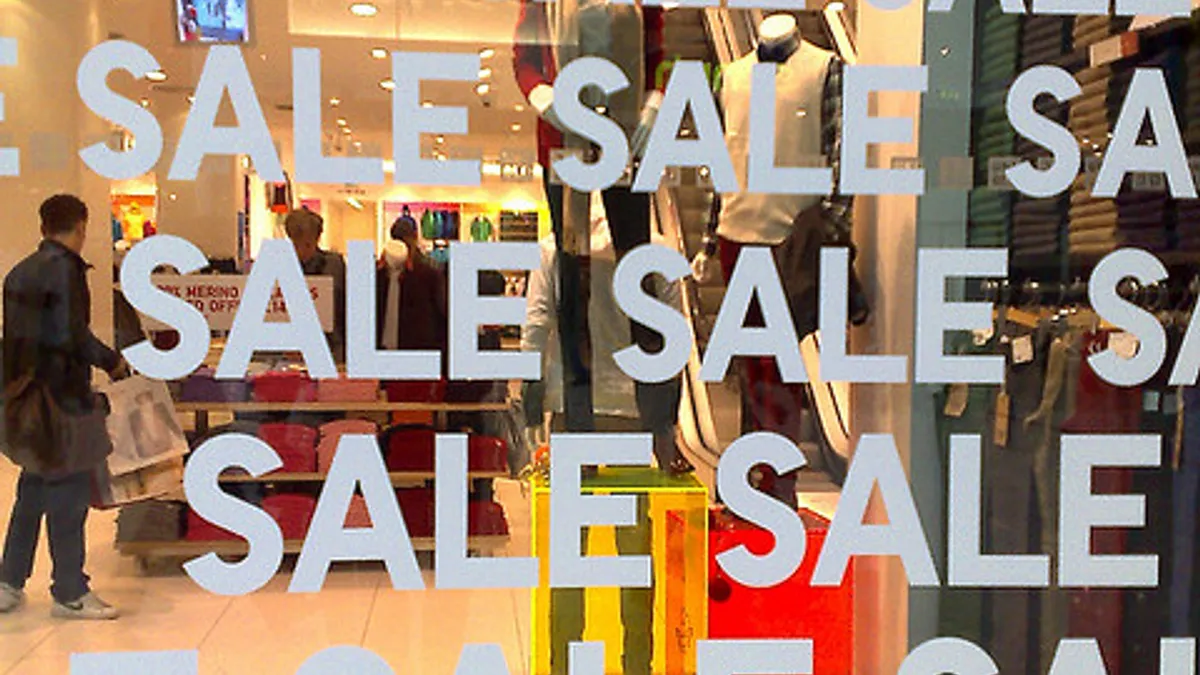Dive Brief:
- American apparel retailers in the first quarter continued to be forced into discounts. American Eagle Outfitters’ discounting in April hit a seven-year high after trending lower in March, and Gap Inc.’s discounting also hit seven-year highs in February and March, though they ended the quarter in April slightly lower, according to a Q1 U.S. Apparel Discounting Index from Morgan Stanley emailed to Retail Dive.
- Abercrombie & Fitch’s discount activity trended higher each month of the quarter, according to the report. Department stores also saw a lot of discounts in the quarter, with Nordstrom promotions trending higher each month and J.C. Penney’s promoting more in April after five-year lows in February and March.
- Executives at Gap, Abercrombie and American Eagle in March were all asked by analysts about their promotional levels and all said they are working to align their supply chains to avoid discounting this year.
Dive Insight:
The holidays are a high-pressure time for retailers to meet consumer expectations for blockbuster sale prices, and discounts often continue into the first quarter to clear inventory. But U.S. apparel retailers have been buffeted by the low prices found at fast fashion stalwarts like H&M and Forever 21 and at off-price retailers like T.J. Maxx, and that is squeezing margins.
"We want to keep our customer excited and engaged all year round," American Eagle CEO Jay Schottenstein told analysts in March, according to a transcript from Seeking Alpha. "We are confident and know we can do that in the first three quarters of the year with less promotional activity. And Q4 is just a highly promotional time period ... just like any other brand, we have to play to win in that quarter. And that’s what we did. We played and we won."
The specialty retailers called out in Morgan Stanley's report say they are working to get their merchandise mix right in order to avoid over-stacking sale racks. Much of that involves righting the supply chain, speeding up production and employing analytics to ensure that supply meets demand.
"[W]hat we're really trying to do is to make sure that we build a plan around the product that we have and that we don't over-discount product even if it comes in late relative to its out dates," Gap Inc. CEO Art Peck told analysts in March, according to a transcript from Seeking Alpha. "So again, traffic is strong and we're working to make sure the rest of the levers in the box don't move negatively as well, but we do expect there to be some promotional pressure."
That also means getting the customer experience in stores right, according to Abercrombie CEO Fran Horowitz. The retailer has embarked on a new store concept that is expanding after initial tests. This year, the retailer will open four new stores using the prototype it runs in select areas and will remodel eight others along those lines, according to CFO Scott Lipesky. The company has closed over 400 stores since 2010, and last year the company remodeled 35 Hollister stores and seven new A&F prototype stores, which included the downsizing of 16 existing stores. And the company closed 39 stores, fewer than the 60 executives expected going into last year.
"[W]e have proven to be able to step away from promotional activities as we see the customer responding to our assortments and it's really the combination of getting the voice, the marketing, the product and the experience all aligned," Horowitz said in March, according to a Seeking Alpha transcript of the company’s fourth quarter call with analysts. "And as those things fall into place, we have been able to in the past and we expect to continue to be able to step away from promotional activity and drive that regular priced business back into the business in 2018. And then in terms of driving traffic, there are a number of levers that we're using to drive traffic. And we're moving away from having promotions be the only lever."
Promotions do continue to be a lever for retailers, although Morgan Stanley analysts did note that, overall, they are abating. "[G]ross margin risk in aggregate appears balanced exiting Q1," according to their note. "The correlation between our U.S. Apparel Discounting Index and retailers' gross margins is 72% excluding the impact of 2011/2012's cotton price swings. Including this time frame, the correlation is 59%."













